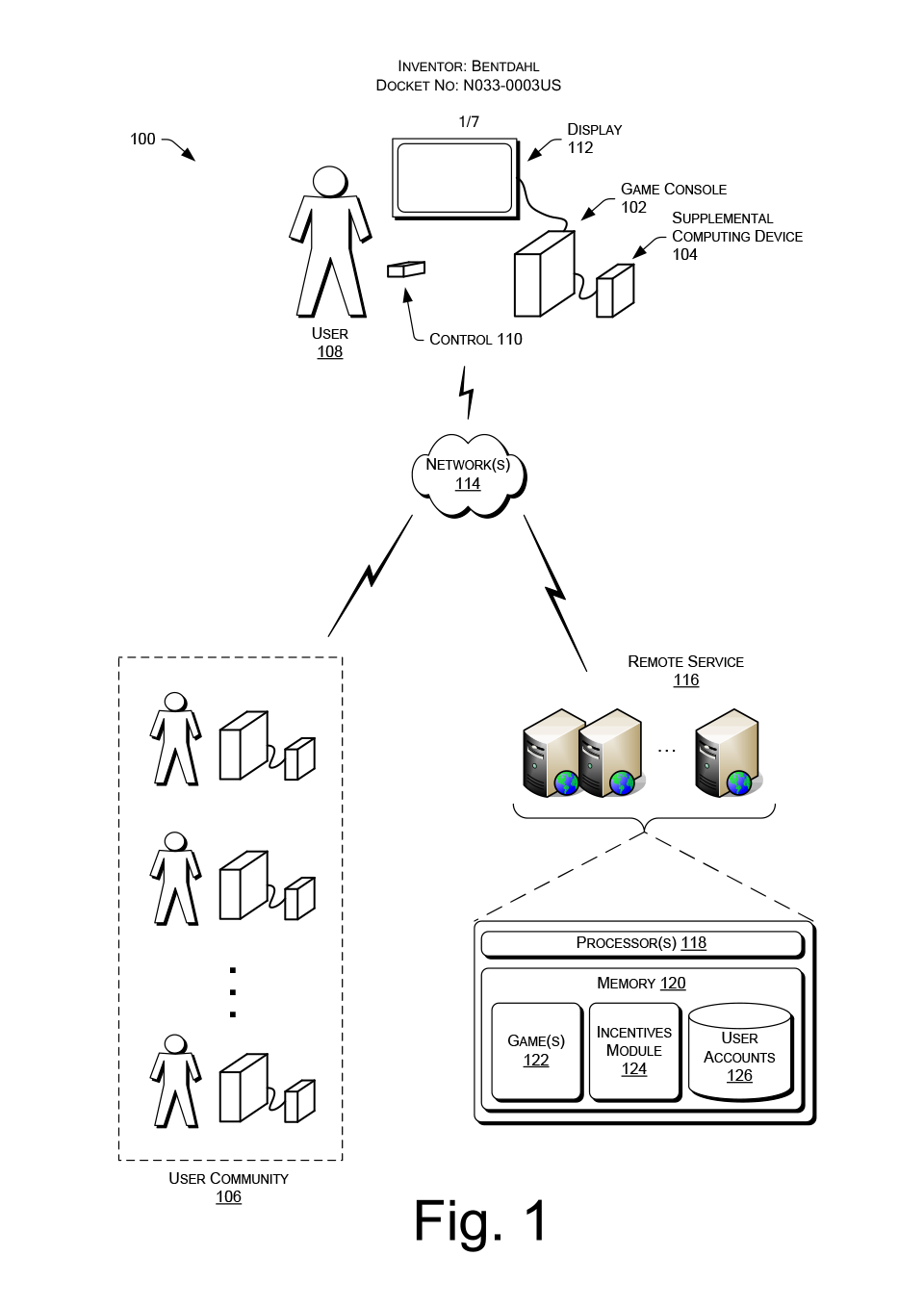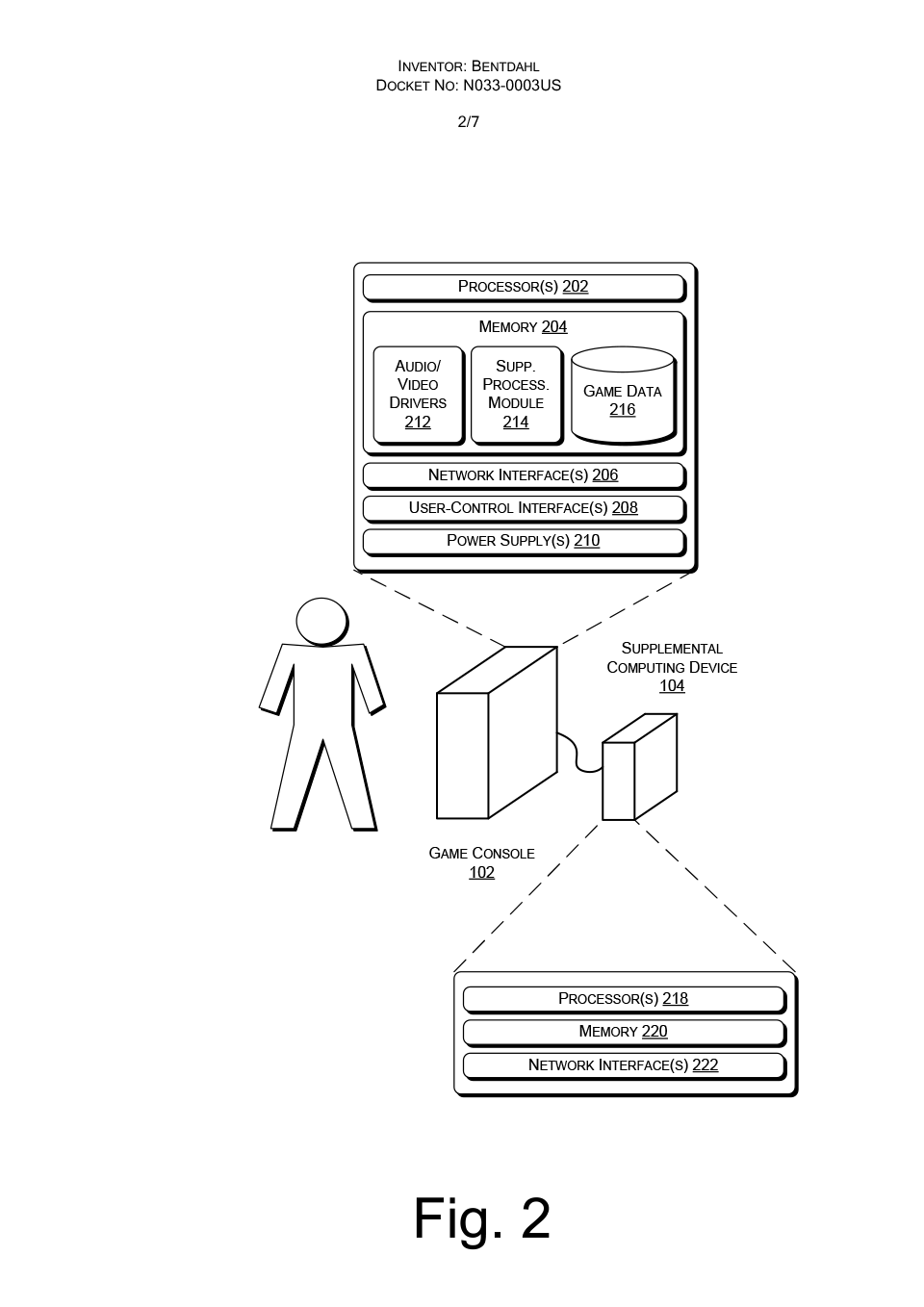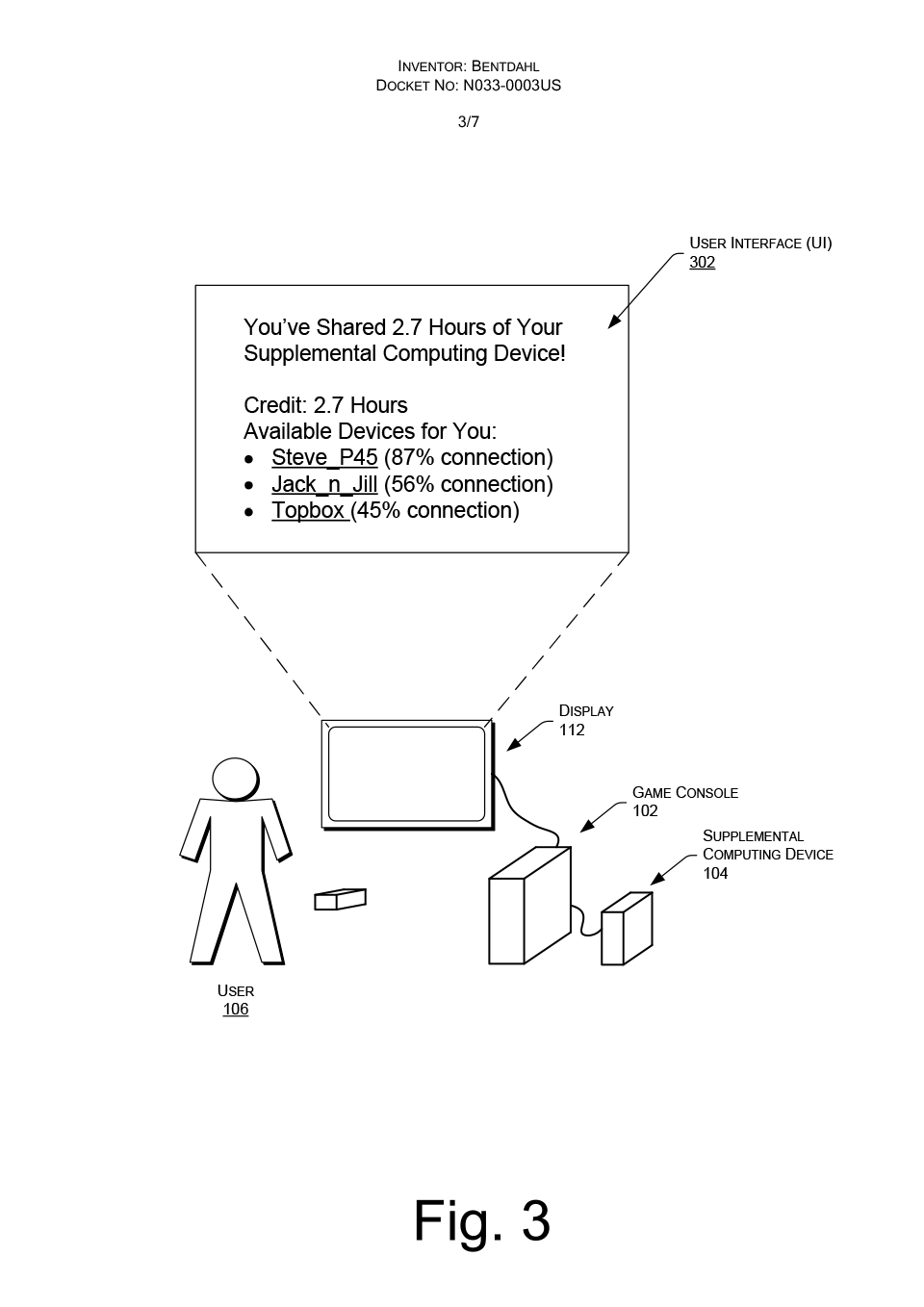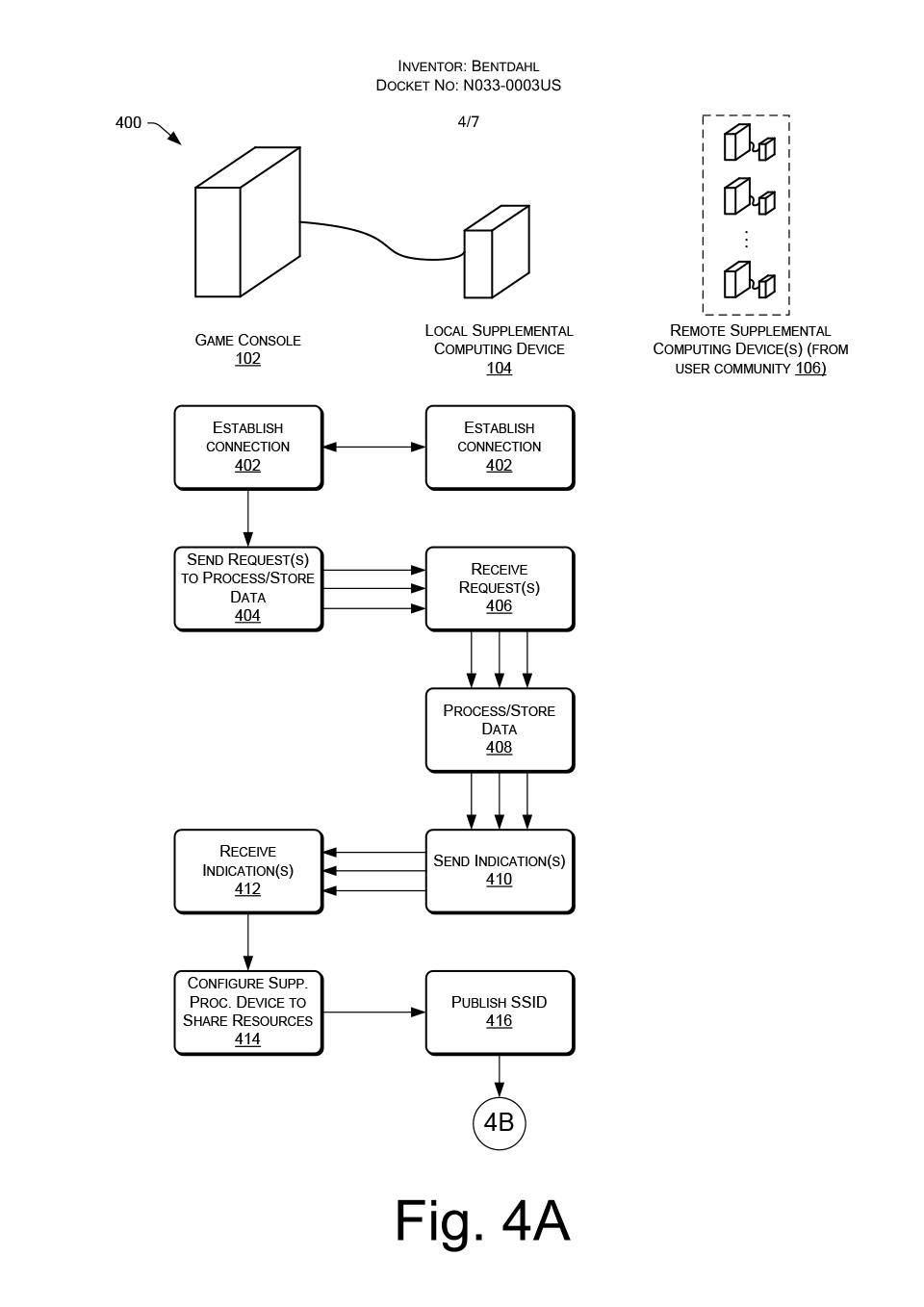R
Rösti
Unconfirmed Member
Disclaimer: I wanted the thread title to be "Nintendo files patent application for Supplemental Computing Devices For Game Consoles (cloud gaming)", but that didn't fit. Hopefully the current title should be sufficient.
On June 3, 2014, Nintendo Co., Ltd filed in the US via the USPTO a patent application titled "Supplemental Computing Devices For Game Consoles". It describes certain supplemental devices that a game console may utilize to increase the speed or quality of a user's gaming experience (in a cloud gaming context primarily); the device may provide processing and/or storage resources to game consoles to assist these game consoles in executing a game or performing other tasks (viewing or editing photos, watching videos, etc.) on the game console, among many other things. I find this quite peculiar, so let's dig into it. Here's the abstract and a few excerpts, and as usual the images (in very high quality this time). Interesting parts bolded/underlined.
Additionally, there is a foreign reference to a European patent by Deutsche Telekom AG for "Method and system of using networked virtual machines of mobile devices in the cloud to provide mobile applications and services". There's also some prior art to Nintendo's filing, but it's currently not available via USPTO's PAIR.
This appears to be Joseph Bentdahl's first patent for Nintendo. He's a Technical Services Specialist at NoA, responsible for these things:
Images







Or search for application number 14/294704 at http://appft.uspto.gov/netahtml/PTO/search-bool.html.
Quite an interesting pattern, especially the benefits you may gain by sharing your resources with other players. If this is somehow related to NX we can of course only speculate about, but I think it could be a good fit and with Nintendo's plans for Nintendo Account/My Nintendo etc., it only seems like a logical step on the way. There you have it anyway.
On June 3, 2014, Nintendo Co., Ltd filed in the US via the USPTO a patent application titled "Supplemental Computing Devices For Game Consoles". It describes certain supplemental devices that a game console may utilize to increase the speed or quality of a user's gaming experience (in a cloud gaming context primarily); the device may provide processing and/or storage resources to game consoles to assist these game consoles in executing a game or performing other tasks (viewing or editing photos, watching videos, etc.) on the game console, among many other things. I find this quite peculiar, so let's dig into it. Here's the abstract and a few excerpts, and as usual the images (in very high quality this time). Interesting parts bolded/underlined.
Additionally, there is a foreign reference to a European patent by Deutsche Telekom AG for "Method and system of using networked virtual machines of mobile devices in the cloud to provide mobile applications and services". There's also some prior art to Nintendo's filing, but it's currently not available via USPTO's PAIR.
Abstract
Supplemental computing devices that provide processing and/or storage resources to game consoles to assist these game consoles in executing a game. In some instances, a game console locally executes a copy of a game using resources of the game console. In addition, however, the game console may couple to a supplemental computing device that includes resources that the game console may also utilize to increase the speed or quality of a user's gaming experience. For instance, the supplemental computing device may couple via a physical connection (e.g., a wired connection) to the game console for processing data associated with the game and providing a result back to the console, and/or for storing game data on behalf of the game console.
Inventors: Bentdahl; Joseph Thomas; (Kirkland, WA)
Applicant: Nintendo Co., Ltd Redmond WA US
Assignee: Nintendo Co., Ltd
Redmond
WA
Family ID: 1000001015722
Appl. No.: 14/294704
Filed: June 3, 2014
This appears to be Joseph Bentdahl's first patent for Nintendo. He's a Technical Services Specialist at NoA, responsible for these things:
- New hardware project coordination.
- Develop layout and content of Service Support Manuals.
- Mentor and train NOA Technicians, Facilitators, and Associates.
- Train Subcontractors from Canada, Latin America, and US
- Validate and create part numbers for test software.
Claims
1. A gaming system, comprising: a game console comprising one or more processors configured to locally execute a game and provide video output of the game to a display and audio output of the game to a speaker, the game console including a physical network interface and a wireless communication interface; and a supplemental computing device configured to detachably couple to the game console via the physical communication interface, the supplemental computing device comprising: one or more processors configured to provide, over the physical communication interface, processing resources to the game console to assist the game console in locally executing the game; and memory for receiving data associated with the game from the game console and storing the data for later access by the game console wherein the game console is further configured to couple, via the wireless communication interface, to another supplemental computing device, the another supplemental computing device including one or more processors to provide processing resources to the game console and memory for providing storage resources to the game console.
6. An apparatus comprising: a housing; an interface for coupling the apparatus with a game console; one or more processors residing within the housing; and logic residing within the housing and configured to cause the one or more processors to perform acts comprising: receiving, while the apparatus is coupled to the game console via the interface and while the game console is executing a game, a first request from the game console to process first data associated with the game; processing, at least partly in response to the first request, the first data to create a result; providing the result back to the game console; receiving, while the apparatus is coupled to the game console via the interface and while the game console is executing the game, a second request from the game console to store second data associated with the game; and storing the second data at the apparatus at least partly in response to the second request.
9. The apparatus as recited in claim 6, the acts further comprising broadcasting a service set identification (SSID) associated with the apparatus such that game consoles that are remote from the apparatus may wirelessly communicate with the apparatus.
BACKGROUND
[0001] Users play an array of different games on an array of different types of game consoles. In some instances, these consoles execute games locally on the consoles, using the processing, storage, and other resources of the console. However, for some games--including games in which players play simultaneously against each other while located at different locations--the capabilities of the local console are not sufficient. Therefore, some gaming has moved "into the cloud". That is, server devices located at central locations (e.g., servers maintained by a producer of a game) may host or otherwise execute portions of a game, given that these server devices often have processing and storage capabilities that far exceed those of local game consoles. However, given that the servers need to receive information from and send information to the game consoles, the quality of "cloud gaming" relies heavily on the latency of the network between the server devices and the game console. Stated otherwise, a high degree of network latency may significantly degrade the gaming experience of the user.
Images

[0003] FIG. 1 illustrates an example environment that includes a game console locally executing a game, as well as a supplemental computing device coupled to the console for supplementing processing and storage resources of the game console. In addition, the environment includes multiple other game console and supplemental computing device combinations, such that the game consoles may utilize nearby supplemental computing devices to even further supplement the game-console resources.

[0004] FIG. 2 illustrates select components of a game console and a supplemental computing device from FIG. 1.

[0005] FIG. 3 illustrates an example user interface (UI) that a game console may display to allow a user to select a supplemental computing device that is remote from the game console to assist the game console in executing a game.



[0006] FIGS. 4A-C collectively illustrate a process for utilizing supplemental computing devices using the techniques described herein.

[0007] FIG. 5 illustrates a flow diagram of a process for providing some form of compensation to a user who shares resources of a supplemental computing device coupled to a game console of the user to other users in a network.
Detailed descriptions
[0009] In some instances, a supplemental computing device may also be used by other "remote" game consoles--or game consoles that do not locally (e.g., physically) couple to the supplemental computing device. For instance, the supplemental computing device may include a wireless communication interface (or may utilize the wireless communication interface of its local game console) to communicate with the remote game consoles over a network. The remote game consoles may then use the processing and/or storage resources of the supplemental computing device similar to how the local game console utilizes these resources, albeit in a wireless manner.
[0013] In some instances, a user may be compensated based on an amount (e.g., time, raw resources, etc.) that the user shares his or her supplemental computing device or indicates that he or she is willing to share the supplemental computing device. This compensation may comprise any form of value, include access (e.g., time) to other supplemental computing devices maintained by other users, discounts on games, access to certain game content, points for redemption for digital or physical goods, information for display (e.g., as a badge) on a social network, or the like.
[0020] In instances where a game console utilizes resources from a remote supplemental computing device, the game console may couple to a supplemental computing device that is relatively "close" within a network. That is, the game console 102, or the coupled supplemental computing device 104, may identify other supplemental computing devices that have a threshold connection strength with the game console 102 or the supplemental computing device 104, or through which communications between the respective endpoints are less than a network latency threshold. By coupling to these devices, the techniques described herein limit the latency between the devices. The other supplemental computing devices could be within a relatively short distance (e.g. within the same household, building, or neighborhood) or could be some distance away. In some embodiments, the network distance can affect the types of functionality that the supplemental computing devices may provide. Network distance can be a measurement of latency between the game console and the respective supplemental computing device and/or the actual or estimated number of network hops between the console and the network computing device, for example. Thus in terms of network distance, a network computing device that is "close" has relatively low latency or hops, and one that is "far away" has relatively large latency or numbers of hops. Relatively close supplemental computing devices may be able to provide services at a nearly real-time speed (e.g. processing real-time graphics and sound effects), while relatively far away devices may only be able to provide asynchronous or supplementary support to the events occurring on the console (e.g. providing for weather effects in games, artificial intelligence (AI), etc.). In some cases the supplementary support provided by the supplemental computing devices could be based on a best-effort basis. For example, in a computer chess game, some amount of onboard AI may be possible on board the console to provide relatively quick analysis, but supplemental computing devices may perform additional AI analysis. If the additional analysis is not received from the supplemental computing devices within a threshold time, the console can use what is available to it (e.g. the analysis done by the console or by any supplemental computing device that has returned its respective AI analysis).
[0023] As described in further detail below, a game console may also couple to multiple supplemental computing devices to even further increase capabilities of the resulting game system. For instance, multiple supplemental devices may be daisy-chained to one another and/or the game console may be physically coupled or wirelessly coupled to other supplemental computing devices.
Source: http://appft.uspto.gov/netacgi/nph-...tendo.AANM.&OS=AANM/Nintendo&RS=AANM/NintendoThe example console (just for reference)
[0024] FIG. 2 illustrates select example components of the game console 102 and the supplemental computing device 104 from FIG. 1. The game console 102 may take the form of any suitable type of computing device, e.g., mobile, semi-mobile, semi-stationary, or stationary. Some examples of a game console may include a "dedicated game console" in which the sole or primary purpose is to cause output (e.g., visually and audibly) of games for play by a user, potentially with use of a remote control, but potentially without. The game console may include its own display and/or be configured to be easily connected to external displays like televisions and projectors. In other instances, game consoles may take the form of tablet computing devices, smart phones or mobile communication devices, laptops, netbooks and other portable computers or semi-portable computers, desktop computing devices, terminal computing devices and other semi-stationary or stationary computing devices, wearable computing devices, or other body-mounted computing devices, or other computing devices capable of sending communications and performing the functions according to the techniques described herein.
Or search for application number 14/294704 at http://appft.uspto.gov/netahtml/PTO/search-bool.html.
Quite an interesting pattern, especially the benefits you may gain by sharing your resources with other players. If this is somehow related to NX we can of course only speculate about, but I think it could be a good fit and with Nintendo's plans for Nintendo Account/My Nintendo etc., it only seems like a logical step on the way. There you have it anyway.



